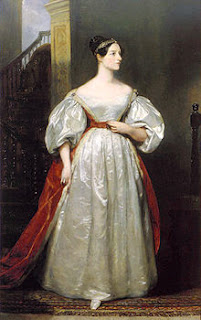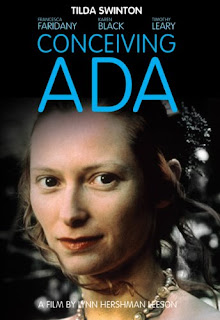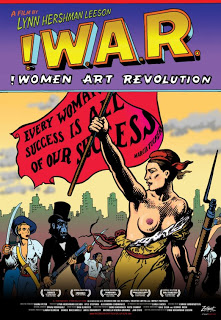So why don’t we know more women in art? It’s a case of omission, of erasing women and their contributions out of history. A stunning film 40 years in the making, “!Women Art Revolution” seeks to fill that gap by combining “intimate” interviews along with visceral visual images of paintings, performance art, installation art, murals and photography.
Let’s play a game. Name three artists…go on. Now who comes to mind? Picasso? Monet? Michelangelo? Now what if I asked you to name three female artists. You probably would think of Frida Kahlo or Georgia O’Keefe. But what about other women like Judy Chicago, Kathe Kollwitz, Ana Mendieta or Miranda July? This very query of naming a mere three female artists, opens the compelling documentary
!Women Art Revolution. Sadly, the people questioned, visitors exiting museums in NYC and San Francisco, could only think of Frida Kahlo. If you had asked those same people to name male artists, or just stated “artists” without indicating gender, I’m sure they would have rattled off a lengthy list…of men.
So why don’t we know more women in art? It’s a case of omission, of erasing women and their contributions out of history. A stunning film 40 years in the making,
!Women Art Revolution seeks to fill that gap by combining “intimate” interviews along with visceral visual images of paintings, performance art, installation art, murals and photography. Director
Lynn Hershman Leeson, a performance artist and filmmaker, began interviewing people, friends and colleagues who visited her apartment in the 1970s, continuing to interview artists, curators, historians, critics and professors for the next 4 decades. She narrates the film, becoming its conscience, observer and participant. Chronicling the convergence of feminism and art, fueled by anti-war and civil rights protests and the inception of the Feminist Art Movement in the 60s, the documentary depicts how women activists have fought to express their vision and have their voices heard in the art scene.
Difficult to synopsize, the film encompasses a vast breadth of work and activism. In the 70s, female artists created their own spaces and galleries such as WomanHouse, a feminist installation founded by installation artist Judy Chicago and abstract painter Miriam Schapiro at CalArts in Los Angeles, and A.I.R., an all-female gallery in NYC. Some of the pieces that stand out for me include Yoko Ono’s performance art “Cut Piece,” which consisted of her kneeling while spectators came up to her and snipped pieces of her clothing off with scissors; Faith Ringgold’s quilts depicting African American narratives; and Martha Rosler’s video “Semiotics of the Kitchen” displaying her performance of domestic chores and questioning gender roles.
One of the artists in the film says, “Women have always been looked upon, so we looked back.” This quote struck me. Women have been the muses and the models, but as artists and activists, they examine those gender roles and expectations. Feminist artists challenged norms. They questioned the dominant narrative of gender roles that women belonged as docile wives slaving over a hot stove and that women had to conform to societal beauty standards in a heteronormative world. Interestingly, many artists revealed their marriages suffered and dissolved as a result of their burgeoning outspokenness and activism.
Throughout the film, Hershman Leeson continually questions gender and power structures. Ana Mendieta, a sculptor, painter, performance and video artist, created images of women in trees, mud and grass using twigs and blood. At the age of 36, she was allegedly killed by her husband, artist Carl Andre. Because he was such a powerful figure in the minimalist movement, no one would speak out against him. As a result, he was acquitted.

!Women Art Revolution showcases the controversy swirling around The Dinner Party, Judy Chicago’s infamous exhibit. A powerful feminist installation piece, it consists of a massive triangular-shaped banquet table with 39 place settings. Each plate, utensils, chalice and placemat decorated with colors and iconography unique for the intended guests: various famous women throughout history and myth. Chicago created a groundbreaking piece that puts women front and center, something often lacking in the media. Apparently, The Dinner Party caused the government unease and even outrage. Accused of being pornographic due to the butterfly and floral plates symbolizing the vulva, the U.S.House debated on whether or not it should be displayed. Yes, because vaginas are soooo scary. Some Representatives, all male, said it wasn’t art. Um, who are they to determine that?! One Congressman, a former Black Panther, defended the piece saying it was art and protected as free speech. Sadly, the House passed a bill banning it from being exhibited (Oh that’s right, because Congress has nothing better to do! Sigh). Luckily, when it went to the Senate, a small group of wealthy and influential women urged their Senators to drop the legislation, causing it to be dismissed.
The film covers and interviews the Guerilla Girls, an anonymous watchdog group of gorilla mask-wearing feminist activists combating sexism in the international art world. Formed in 1985, an exhibit at the Museum of Modern Art that showcased an international collection of recent artists in painting and sculpture spurred their creation. The exhibit featured 169 artists, only 3 of whom were women. They also looked at the collections in the Metropolitan Museum of Art in 1989 and found that only 3% of the artists in the modern wing were women and 83% of nude subjects were women. This prompted their famous poster tagline, “Do women have to be naked to get into the Met. Museum?” The Guerilla Girls protest and continue to speak out, publishing report cards on gender and racial gaps in other museums, galleries and exhibits. They force the art world to face the reality of its own discrimination.
But gender discrimination didn’t just happen to artists. Museum curators also faced disparities. Marcia Tucker, Founding Director at the New Museum of Contemporary Art, shared her personal story of wage inequity when she was a curator at the Whitney Museum of American Art, the first woman to hold that position there. After she found out she made less than her male counterpart, she confronted the museum’s president who gave her the feeble excuse, “The budget, the budget, the budget.” To which she replied, “The New York Times, The Daily News, The New York Post.” While things have certainly improved, there’s still a long way to go in reducing wage gaps as women still earn far less than men today.
!Women Art Revolution easily could have become dull with dry facts or depressing due to the obstacles the female artists struggled against. Yet it pulses and throbs with fervent energy. Like a little feminist sponge, I soaked up all of the passion, activism and information. With images of women, hearing women’s voices and a score composed by Carrie Brownstein, Sleater-Kinney guitarist and Portlandia actor, the film feels like a safe haven for feminists. In our male-dominated media, it was inspiring to see a riveting documentary created by women and featuring women. My only complaint of the film is that it doesn’t really follow a chronological or thematic order, making it feel a bit chaotic. Yet it also makes it feel raw and personal. Interestingly, Hershman Leeson, almost prophetically anticipating this, admits as much in her own chronology, comprised of various pieces knitted together “like a patchwork quilt.” I found it refreshing that Hershman Leeson’s introspection as a documentary filmmaker leads her to question whether or not she should feature her own art in the film. She comes to the rightful conclusion that she should as women have been omitted from art history for too long.
Hershman Leeson said she didn’t know how the film would end; she’d been waiting to see how events would unfold. Without any more threats from douchebag legislators, The Dinner Party now permanently resides at the
Elizabeth A. Sackler Center for Feminist Art, founded in 2007 at the Brooklyn Museum, for future generations to behold. In 2007, the Museum of Contemporary Art (MOCA) featured “
Wack! Art and the Feminist Revolution,” a groundbreaking exhibit showcasing feminist art from 1965 to 1980, the first exhibit of its kind. The documentary also features young feminist artists like
Alexandra Chowaniec. One young artist recalled how her instructor asked if she had ever heard of Ana Mendieta and other artists from the 70s, as her work mirrored that of feminists 40 years earlier. As she hadn’t, she visited the library to learn about them. When she could find no books on women in the Feminist Art Movement, her instructor gave the young artist copies of her own books. The artist admits that she and her generation benefit from the gains women who came before her struggled to achieve, a sentiment that too often leads many women of my generation and younger to deem feminism useless and outdated. But nothing could be further from the truth.
“Of course I think it has positive connotations for intelligent women and men. But there is still an existing fear of the word itself, as well as miscommunicated baggage of what it represents. This needs revision. Feminism is about cultural values and equality. The young women I am in contact with are grateful to learn about this history. They devour the information. It is, after all, their legacy.”
It is this legacy to future generations that means so much to Hershman Leeson. Arising from the documentary, she started the RAW/WAR project, a virtual community allowing people to submit images of drawings, paintings, performances, dance and music, opening up the dialogue of art and gender to a global community. Also, all of the interview transcripts and many of the videos are available online. As to the message of the film, Hershman Leeson declares:
“As Marcia Tucker reminds us, “humor is the single most important weapon we have!” I think audiences will be inspired by the courage, sense of humor and tenaciousness of the artists who courageously and constantly reinvented themselves and in doing so dynamically revised existing exclusionary policies of their culture.”
Art questions, challenges and inspires. While it can be beautiful and serene, it can also be disturbing and uncomfortable, unnerving the viewer, forcing the audience to look at the world around them. The art in this documentary reveals the media’s incessant agenda of writing women out of history. Society views women’s art, their experiences and stories, as lesser than men’s: less important, less noble, less substantial. When I took Art History in college, I remember we only studied a handful of female artists. The Feminist Art Movement is a chapter ripped out of history, a period most people just don’t know. Whether you’re an art aficionado or not, you simply must see and experience this revolutionary and visionary film for yourself. !Women Art Revolution reclaims women’s narratives and manifests a vocal group of dissenters rattling the cages of constriction and conformity, refusing to be silenced.
Trailer:






